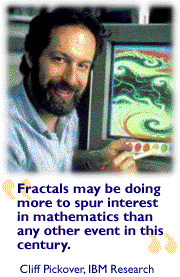Contact |
News! |
Books |
Home |
Contact |
News! |
Books |
Home |
|
Interview previously at IBM Research web site...
When he's not busy developing code for IBM's IntelliStation (IBM's new high-end personal computer), or writing and explaining mathematical concepts to the public, Pickover is exploring ways in which fractals and computerized visualization can be stretched for aesthetic as well as practical reasons.
Entering the fractal dimension The work of Pickover and his colleagues at IBM is branching into many areas to explore new ways for using computerized visualization to represent data, illuminate patterns and simulate natural forms. Pickover has worked on topics ranging from the graphical representation of genetic sequences and sounds to the simulation and rendering of huge lifelike caverns (which he calls "virtual caverns" because they can be explored using computer tools).
|

Fractal Questions and Answers
|
|
"Fractals are also useful in computer science. For example, we can use what we've learned from studying fractals
to compress images in computers so they take up less room," he says. "In general, I see graphics of fractals as
part of the field of scientific visualization -- the melding of art and science in which we're making the unseen
visible."
Learning from the masters Pickover's love of fractals and the general field of computerized visualization has made him one of the more prolific scientists at IBM. He has authored or edited more than 16 books on fractals, mathematics and other topics, including Fractal Horizon, which covers the many uses for fractals; Keys to Infinity, which explores the concepts of very large numbers and infinite regression; and the recently published Loom of God, which looks at mathematics and mysticism from a historical perspective. He has contributed articles to The Washington Post, BYTE, and Wired, and has been featured on The Discovery Channel and CNN. Referring to his creative thinking and visualization work, Wired magazine recently wrote, "Bucky Fuller thought big, Arthur C. Clarke thinks big, but Cliff Pickover outdoes them both." See Pickover's books on fractals here.
Inspiring young minds "When we show students, including those in elementary and high schools, the beautiful forms that come from fractals, it sparks an enormous amount of interest. Students want to know how these images are created," he says. "Particularly when it comes to young minds, fractals may be doing more to spur interest in mathematics than any other event in this century."
|
 For some of Pickover's recent artworks, click
here.
For some of Pickover's recent artworks, click
here.